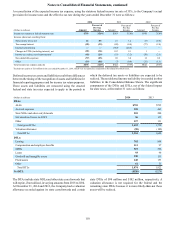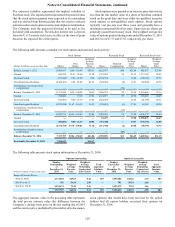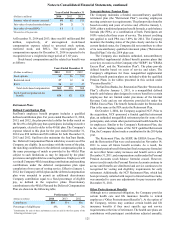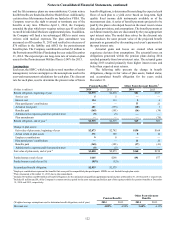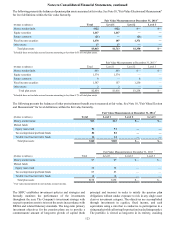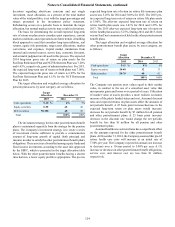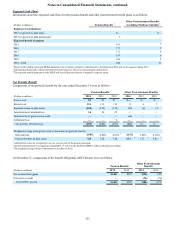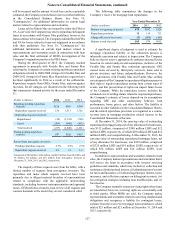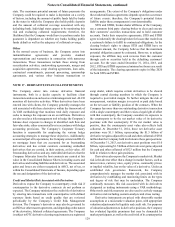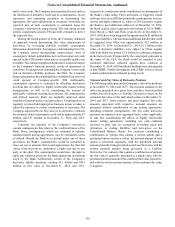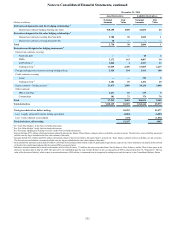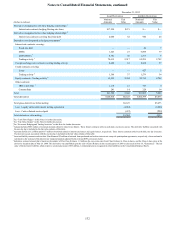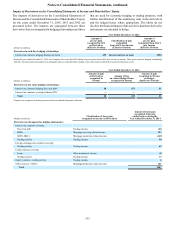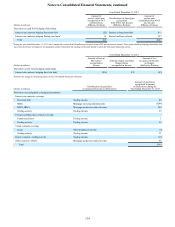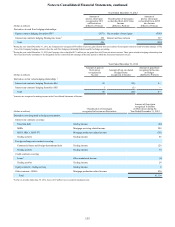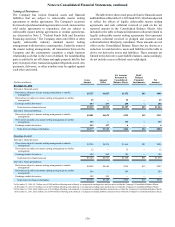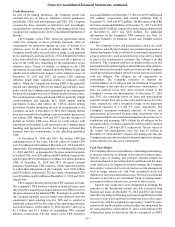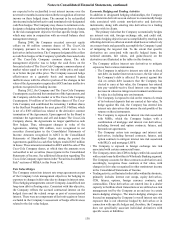SunTrust 2014 Annual Report Download - page 151
Download and view the complete annual report
Please find page 151 of the 2014 SunTrust annual report below. You can navigate through the pages in the report by either clicking on the pages listed below, or by using the keyword search tool below to find specific information within the annual report.Notes to Consolidated Financial Statements, continued
128
Contingent Consideration
The Company has contingent payment obligations related to
certain business combination transactions. Payments are
calculated using certain post-acquisition performance criteria.
The potential obligation is recorded as an other liability,
measured at the fair value of the contingent payments totaling
$27 million and $26 million at December 31, 2014 and 2013,
respectively. If required, these contingent payments will be
payable within the next two years.
Visa
The Company issues credit and debit transactions through Visa
and MasterCard. The Company is a defendant, along with Visa
and MasterCard (the “Card Associations”), as well as several
other banks, in one of several antitrust lawsuits challenging the
practices of the Card Associations (the “Litigation”). The
Company entered into judgment and loss sharing agreements
with Visa and certain other banks in order to apportion financial
responsibilities arising from any potential adverse judgment or
negotiated settlements related to the Litigation. Additionally, in
connection with Visa's restructuring in 2007, shares of Visa
common stock were issued to its financial institution members
and the Company received its proportionate number of shares of
Visa Inc. common stock, which were subsequently converted to
Class B shares of Visa Inc. upon completion of Visa’s IPO in
2008. A provision of the original Visa By-Laws, which was
restated in Visa's certificate of incorporation, contains a general
indemnification provision between a Visa member and Visa that
explicitly provides that each member's indemnification
obligation is limited to losses arising from its own conduct and
the specifically defined Litigation.
Agreements associated with Visa's IPO have provisions that
Visa will fund a litigation escrow account, established for the
purpose of funding judgments in, or settlements of, the
Litigation. If the escrow account is insufficient to cover the
Litigation losses, then Visa will issue additional Class A shares
(“loss shares”). The proceeds from the sale of the loss shares
would then be deposited in the escrow account. The issuance of
the loss shares will cause a dilution of Visa's Class B shares as
a result of an adjustment to lower the conversion factor of the
Class B shares to Class A shares. Visa U.S.A.'s members are
responsible for any portion of the settlement or loss on the
Litigation after the escrow account is depleted and the value of
the Class B shares is fully diluted. In May 2009, the Company
sold its 3.2 million Class B shares to the Visa Counterparty and
entered into a derivative with the Visa Counterparty. Under the
derivative, the Visa Counterparty is compensated by the
Company for any decline in the conversion factor as a result of
the outcome of the Litigation. Conversely, the Company is
compensated by the Visa Counterparty for any increase in the
conversion factor. The amount of payments made or received
under the derivative is a function of the 3.2 million shares sold
to the Visa Counterparty, the change in conversion rate, and
Visa’s share price. The Visa Counterparty, as a result of its
ownership of the Class B shares, is impacted by dilutive
adjustments to the conversion factor of the Class B shares caused
by the Litigation losses.
During 2012, the Card Associations and defendants signed
a memorandum of understanding to enter into a settlement
agreement to resolve the plaintiffs' claims in the Litigation. Visa's
share of the claims represents approximately $4.4 billion, which
was paid from the escrow account into a settlement fund during
2012. During 2013, various members of the putative class elected
to opt out of the settlement which resulted in a proportional
decrease in the amount of the settlement and a deposit of
approximately $1.0 billion from the settlement fund back into
the escrow account. During 2014, Visa deposited an additional
$450 million into the escrow account, bringing the escrow
account to approximately $1.5 billion. The estimated fair value
of the derivative liability was immaterial at December 31, 2014
and 2013, however, the ultimate impact to the Company could
be significantly different if the settlement is not approved and/
or based on the ultimate resolution with the plaintiffs that opted
out of the settlement.
Tax Credit Investments Sold
SunTrust Community Capital, one of the Company's
subsidiaries, previously obtained state and federal tax credits
through the construction and development of affordable housing
properties and continues to obtain state and federal tax credits
through investments in affordable housing developments.
SunTrust Community Capital or its subsidiaries are limited and/
or general partners in various partnerships established for the
properties. Some of the investments that generate state tax credits
may be sold to outside investors. At December 31, 2014,
SunTrust Community Capital has completed six sales containing
guarantee provisions stating that SunTrust Community Capital
will make payment to the outside investors if the tax credits
become ineligible. SunTrust Community Capital also guarantees
that the general partner under the transaction will perform on the
delivery of the credits. The guarantees are expected to expire
within a fifteen year period from inception. At December 31,
2014, the maximum potential amount that SunTrust Community
Capital could be obligated to pay under these guarantees is $19
million; however, SunTrust Community Capital can seek
recourse against the general partner. Additionally, SunTrust
Community Capital can seek reimbursement from cash flow and
residual values of the underlying affordable housing properties,
provided that the properties retain value. At December 31, 2014
and 2013, an immaterial amount was accrued for the remainder
of tax credits to be delivered, and was recorded in other liabilities
in the Consolidated Balance Sheets.
Public Deposits
The Company holds public deposits from various states in which
it does business. Individual state laws require banks to
collateralize public deposits, typically as a percentage of their
public deposit balance in excess of FDIC insurance and may also
require a cross-guarantee among all banks holding public
deposits of the individual state. The amount of collateral required
varies by state and may also vary by institution within each state,
depending on the individual state's risk assessment of depository
institutions. Certain of the states in which the Company holds
public deposits use a pooled collateral method, whereby in the
event of default of a bank holding public deposits, the collateral
of the defaulting bank is liquidated to the extent necessary to
recover the loss of public deposits of the defaulting bank. To the
extent the collateral is insufficient, the remaining public deposit
balances of the defaulting bank are recovered through an
assessment of the other banks holding public deposits in that


